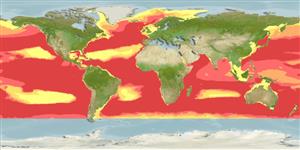>
Lophiiformes (Anglerfishes) >
Ceratiidae (Warty Seadevils)
Etymology: Cryptopsaras: Greek, kryptos =secret, hidden + Greek, psaras = fisherman (referring to this genus' tiny illicial bone, almost entirely covered by tissue of the esca) (Ref. 86949); couesii: Named for the eminent ornithologist Elliot Coues (Ref. 4525).
Eponymy: Dr Elliott Ladd Coues (pronounced ‘cows’) (1842–1899) was a US Army Surgeon who graduated from Columbia University (1861) then being appointed Assistant-Surgeon in the army (1864). [...] (Ref. 128868), visit book page.
More on author: Gill.
Environment: milieu / climate zone / depth range / distribution range
Ecologia
marino batipelagico; distribuzione batimetrica 0 - 3085 m (Ref. 58018), usually 500 - 1250 m (Ref. 36494). Deep-water; 81°N - 52°S, 180°W - 180°E
Circumglobal: tropical and subtropical.
Size / Peso / Age
Maturity: Lm ? range ? - ? cm
Max length : 7.3 cm TL maschio/sesso non determinato; (Ref. 4494); 44.0 cm TL (female)
Short description
Chiavi di identificazione | Morfologia | Morfometria
Spine dorsali (totale) : 1; Raggi dorsali molli (totale) : 4 - 5; Spine anali: 0; Raggi anali molli: 4; Vertebre: 20. A large median and two small lateral oval caruncles immediately in front of origin of dorsal fin (Ref. 13608). Branchiostegal rays: 6 (Ref. 36494).
Males dwarfed, becoming parasitic on females. Maximum size of free-living males is 1.05 cm (Ref. 4494). Females are oviparous, with planktonic larvae (Ref. 36494). Eggs are presumably contained in floating gelatinous rafts (Ref. 36494 ).
Females are oviparous, males are parasitic (Ref. 36494).
Bertelsen, E., 1990. Ceratiidae. p. 510-512. In J.C. Quero, J.C. Hureau, C. Karrer, A. Post and L. Saldanha (eds.) Check-list of the fishes of the eastern tropical Atlantic (CLOFETA). JNICT, Lisbon; SEI, Paris; and UNESCO, Paris. Vol. 1. (Ref. 4494)
IUCN Red List Status (Ref. 130435: Version 2024-1)
Threat to humans
Harmless
Human uses
Can't connect to MySQL database (fbapp). Errorcode: Too many connections
